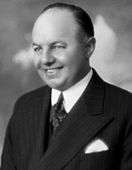1937 Ontario general election
The 1937 Ontario general election was held on October 6, 1937, to elect the 90 Members of the 20th Legislative Assembly of Ontario ("MLAs"). It was the 20th general election held in the Province of Ontario, Canada.
| |||||||||||||||||||||||||||||||||||||||||
90 seats in the 20th Legislative Assembly of Ontario 46 seats were needed for a majority | |||||||||||||||||||||||||||||||||||||||||
|---|---|---|---|---|---|---|---|---|---|---|---|---|---|---|---|---|---|---|---|---|---|---|---|---|---|---|---|---|---|---|---|---|---|---|---|---|---|---|---|---|---|
| |||||||||||||||||||||||||||||||||||||||||
| |||||||||||||||||||||||||||||||||||||||||
The Ontario Liberal Party, led by Mitchell Hepburn, was re-elected for a second term in government, with a slightly reduced majority in the Legislature.
The Ontario Conservative Party, led by William Earl Rowe, was able to win six additional seats, and continued to form the official opposition.
Meanwhile, the fledgling democratic socialist Co-operative Commonwealth Federation (CCF) ran 37 candidates out of a possible 90, led by party president John Mitchell running in Waterloo South, who also campaigned throughout the province on the party's behalf.[1] The election, however, resulted in a modest decline in popular vote and the loss of the party's sole MLA, Sam Lawrence in Hamilton East.
Incumbent MLA Farquhar Oliver was the last remaining United Farmers of Ontario MLA and ran as the party's sole candidate in the election. In practice, however, he had been a supporter of the Liberal government and would join Hepburn's cabinet in 1940, formally joining the Liberal Party.
In 1938, MLAs voted to adopt the title "Member of Provincial Parliament", and became known as "MPPs".
This Ontario election was the last to date in which the winning party has won an absolute majority of the popular vote.
Results
| Party | Leader | 1934 | Elected | % change | Popular vote | ||
|---|---|---|---|---|---|---|---|
| % | change | ||||||
| Liberal | Mitchell Hepburn | 65 | 63 | -3.1% | 51.6% | +1.2% | |
| Liberal–Progressive1 | 4 | 2 | -50.0% | ||||
| Conservative | William Earl Rowe | 17 | 23 | +35.3% | 40.0% | 0.2% | |
| United Farmers2 | Farquhar Oliver | 1 | 1 | - | |||
| Co-operative Commonwealth | John Mitchell as party president[2] |
1 | - | -100% | 5.6% | -1.4% | |
| Liberal Independent | - | 1 | |||||
| Labour | 1 | - | - | ||||
| Independent | 1 | - | |||||
| Total | 90 | 90 | - | 100% | |||
1Liberal-Progressive MLAs supported the Hepburn government since its election in 1934. Liberal-Progressive MLA Harry Nixon sitting in Hepburn's cabinet from the beginning and formally became a Liberal in 1937.
2United Farmers MLA Farquhar Oliver was a supporter of the Hepburn Liberal government and joined Hepburn's cabinet in 1940.
See also
- Politics of Ontario
- List of Ontario political parties
- Premier of Ontario
- Leader of the Opposition (Ontario)
References
- "266 to contest Ontario seats". Montreal Gazette. 30 September 1937. Retrieved 7 February 2016.
- "Total of 266 Candidates Nominated for Oct. 6 Ontario Election: 86 Liberals in Fight And 89 Conservatives; Others of Varied Hue Nominees in Four Ridings Not Being Contested by Party in Power Regarded as Friendly TWO WOMEN RUNNING". Globe and Mail. 30 September 1937.
